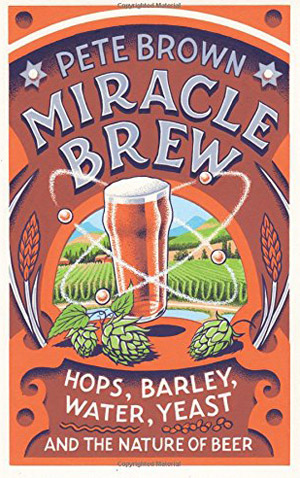 Beer writer Pete Brown was conducting a tasting of IPAs when a woman in the audience raised her hand to ask a question.
Beer writer Pete Brown was conducting a tasting of IPAs when a woman in the audience raised her hand to ask a question.
“If these beers have got so many hops in, are they still suitable for celiacs?”
He replied that hops don’t contain any glutens.
“Ah, so they’re not barley hops then?”
He offers this story as a footnote in his latest book, Miracle Brew, writing that “ironically, she could only misunderstand beer so dramatically because, compared to most people she was better informed and more engaged.”
Brown is currently
Miracle Brew examines beer’s basic ingredients in a similar consumer-friendly way, unafraid to dig into science, but not with the brewer-oriented detail found in the Brewing Elements Series from Brewers Publications. (And, yes, I wrote one of those books. Quite honestly, I’ve heard more than once there are parts brewers felt a need to read two or three times because of the technical detail.) It is a book for people who consider learning to be an adventure, or more simply for people who enjoy reading, rather than anybody intent on learning how to brew beer.
It is not a reference book. In fact, Ed Wray has provided the “anal retentive OCB Wiki style commentary on where I think he went wrong, or more information is needed.” Details are always important, and misstatements bother some of us (guilty here) more than others, but even those who have moved well beyond identifying the components of the German Reinheitsgebot will learn something. (The takeaway: doublecheck any facts before footnoting.)
Brown has not abandoned those who giggled throughout Hops and Glory or Three Sheets to the Wind in order to impress those of us who have already wandered too deep into the rabbit hole. The book was funded initially through Unbound (and you’ll find my name in the back among the many who agreed upfront to buy a copy), but he did not consult with backers before he chose decidedly idiosyncratic route he took to learn about the where and how of growing beer. For instance, the hops section he begins in the Czech Republic, dives into history, returns to the Czech Republic, wanders about England (going deepest into the region of Kent), heads to Slovenia, returns to Kent for a harvest, journeys to the Yakima Valley, goes back to Kent again, travels to Australia, and finishes in Kent. I do not recall reading the word isomerization even one time.
At the outset, Brown writes, “There are miracles in each of beer’s four key ingredients, and when you string these miracles together, the straightforward, supposedly simple drink that emerges is in fact an extraordinary cocktail of natural wonders and human ingenuity that is underrated even by its most ardent fans.” Quite obviously, he traveled to see this with his own eyes. And he noticed a few other things as he did.
At England’s National Collection of Yeast Cultures he introduces readers to Chris Bond and Steve James.
“The most ignorant people I’ve ever met are those who think they know everything. The cleverest are those who at least have some idea of how much the don’t know,” he writes. “Throughout my journeys on this book, I’ve learned ten time more about beer than I knew before, and I thought I know a lot before I started. Here, toward the end of those journeys, I’ve realised I know far less about yeast than I thought. Between them, what Chris and Steve don’t know about yeast is staggering, and the amount they don’t know seems to be increasing with every scientific advance.”